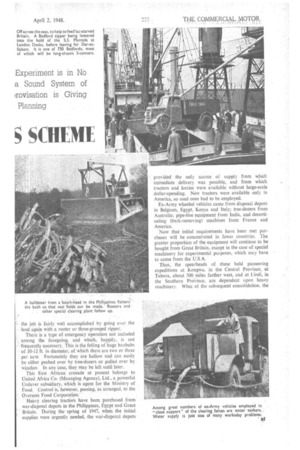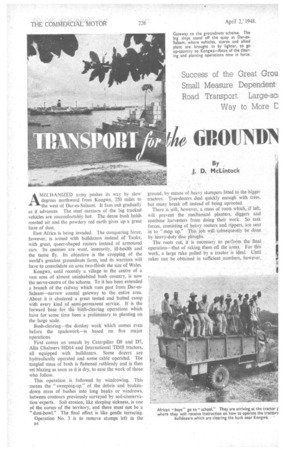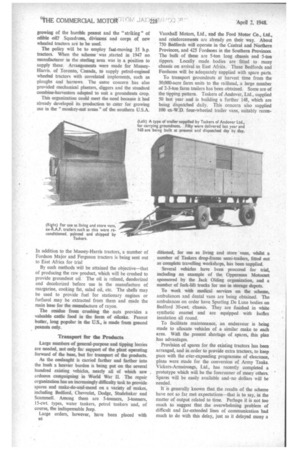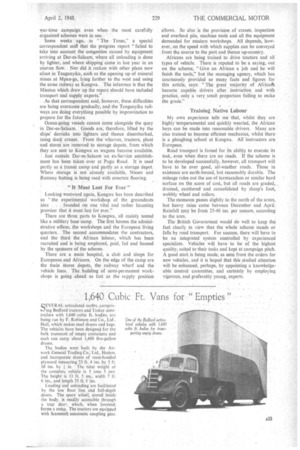S OHI E li t By J. D. McLintock
Page 39

Page 38

Page 40

Page 43

If you've noticed an error in this article please click here to report it so we can fix it.
Success of the Great Grou Small Measure Dependent Road Transport. Large-so Way to More E Experiment is in No a Sound System of trovisation is Giving Planning
AMECHANIZED army pushes its way by slow degrees northward from Kongwa, 250 miles to the west of Dar-es-Salaam. It fans out gradually as it advances The steel carcases of the big tracked vehicles are uncomfortably hot. The dense bush holds roasted air and the powdery red earth gives up a great haze of dust.
East Africa is being invaded. The conquering force, however, is armed with bulldozers instead of Tanks; with great, queer-shaped rooters instead of armoured cars. Its enemies are want, insecurity, ill-health and the tsetse fly. Its objective is the cropping of the world's greatest groundnuts farm, and its warriors will have to consolidate an area two-thirds the size of Wales.
Kongwa, until recently a village in the centre of a vast area of almost uninhabited bush country, is now the nerve-centre of the scheme. To it has been extended a branch of the railway which runs past from Dar-esSalaam—nar row coastal gateway to the entire area. About it is clustered a great tented and hutted camp with every kind of semi-permanent service. It is the forward base for the bush-clearing operations which have for some time been a preliminary to planting on the large scale.
Bush-clearing—the donkey work which comes even before the spadework—is based on five major operations.
First comes an assault by Caterpillar D8 and D7, Allis Chalmers HD14 and International TD18 tractors, all equipped with bulldozers. Some dozers are hydraulically operated and some cable operated. The tangled mass of bush is flattened ruthlessly and is then set blazing as soon as it is dry, to ease the work of those who follow.
This operation is followed by windrowing. This means the " sweeping-up " of the debris and brokendown mass of bushes into long banks or windrows, between contours previously surveyed by soil-conservation experts. Soil erosion, like sleeping sickness, is one of the curses of the territory, and there must not be a "dust-bowl." The final effect is like gentle terracing.
Operation No. 3 is to remove stumps left in the ground, by means of heavy stumpers fitted to the bigger tractors. Tree-dozers deal quickly enough with trees, but many break off instead of being uprooted.
There is still, however, a mass of roots which, if left, will prevent the mechanical planters, diggers and combine harvesters from doing their work. So task forces, consisting of heavy rooters and rippers, are sent in to mop up." This job will subsequently be done by heavy-duty disc ploughs.
The roots cut, it is necessary to perform the final operation—that of raking them off the areas. For this work, a large rake pulled by a tractor is ideal. Until rakes can be obtained in sufficient numbers, however.
the job is fairly well accomplished by going over the land again With a rooter or three-pronged ripper.
There is a type of emergency operation not included among the foregoing, and which, happily, is not frequently necessary.. This is the felling of huge baobabs of 10-12 ft. in diameter, of which there are two or three per acre. Fortunately they are hollow and can easily be either pushed over by tree-dozers or pulled over by winches. In any case, they may be left until later.
This East _African crusade at present belongs to United Africa Co. (Managing Agency), Ltd., a powerful Unilever subsidiary, which is agent for the Ministry of Food. Control is, however, passing, as arranged, to the Overseas Food Corporation.
Heavy clearing tractors have been .purchased from war-disposal depots in the Philippines, Egypt and Great Britain. During the spring of 1947, when the initial supplies were urgently needed, the war-disposal depots
provided the only source of supply from which immediate delivery was possible, and from which tractors and lorries were available without large-scale dollar-spending. New tractors were available only. in America, so used ones had to be employed.
Ex-Army wheeled vehicles came from disposal depots in Belgium, Egypt, Kenya and Italy; tree-dozers from Australia; pipe-line equipment from India, and decorticating (bark-removing) machines from France and America.
Now that initial requirements have been met purchases will be concentrated in fewer countries. The greater proportion of the equipment will continue to be bought from Great Britain, except in the case of special machinery for experimental purposes, which may have to come from the U.S.A.
Thus, the spearheads of these bold pioneering expeditions at Kongwa. in the Central Province, at Tabora, about 300 miles farther west, and at Lindi, in the Southern Province, are dependent upon heavy machinery. What of the subsequent consolidation, the growing of the humble peanut and the " striking " of edible oil? Squadrons, divisions and corps of new, Wheeled tractors are to be used.
The policy will be to employ fast-moving 35 h.p. tractors. When the scheme was started in .1947 no manufacturer in the sterling area was in a position to supply these. Arrangements were made for MasseyHarris, of Toronto, Canada, to supply petrol-engined wheeled tractors with correlated implements, such as ploughs and harrows. The same concern has also provided mechanical planters, diggers and the standard combine-harvesters adapted to suit a groundnuts crop.
This organization could meet the need because it had already developed its production to cater for growing use in the "monkey-nut areas of the southern U.S.A.
In addition to the Massey-Harris tractors, a number of Fordson Major and Ferguson tractors is being sent out to East Africa for trial By such methods will be attained the objective—that of producing the raw product, which will be crushed to provide groundnut oil. The oil is relined, deodorized and decolorized before use in the manufacture of margarine, cooking fat, salad oil, etc. The shells may be used to provide fuel for stationary engines or furfurol may be extracted from them and made the main base for the manufacture of rayon.
The residue from crushing the nuts provides a valuable cattle food in the form of oikake. Peanut butter, long popular in the U.S., is made from ground peanuts only.
Transport for the Products
Large numbers of general-purpose and tipping lorries are needed, not only fo:' support of the plant operating forward of the base, but for transport of the products.
As the onslaught is carried farther and farther into the bush a heavier burden is being put on the several hundred existing vehicles, nearly all of which saw arduous campaigning in World War IL The repair organization has an increasingly difficulty task to provide spares and make-do-and-mend on a variety of makes, including Bedford, Chevrolet, Dodge, Studebaker and Scammell. Among them are 5-tonners, 3-tonners, 15-cwt. types, water tankers, petrol tankers and, of course, the indispensable Jeep.
Large orders, however, have been placed with Vauxhall Motors, Ltd, and the Ford Motor Co., Ltd., and reinforcements are already on their way. About 750 Bedfords will operate in the Central and Northern Provinces, and 425 Fordsons in the Southern Provinces. The bulk of these are 5-ton long chassis and 5-ton tippers. Locally made bodies are fitted to many chassis on arrival in East Africa. These Bedfords and Fordsons will be adequately supplied with spare parts.
To transport groundnuts at harvest time from the 30,000-acre farm units to the railhead, a large number of 2-3-ton farm trailers has been obtained. Some are of the tipping pattern. Taskers of Andover, Ltd., supplied 50 last year and is building a further 148, which are being dispatched daily. This concern also supplied 100 ex-W.D. four-wheeled trailer vans, suitably recon ditioned, for use as living and store vans, whilst a number of Taskers drop-frame semi-trailers, fitted out as complete travelling workshops, has been supplied.
Several vehicles have been procured for trial, including an example of the. Opperman Motocart sponsored by the Jack Olding organization, and a number of fork-lift trucks for use in storage depots.
To work with medical services on the scheme, ambulances and dental vans are being obtained. The ambulances on order have Spurling De Luxe bodies on Bedford 30-cwt. chassis. They are finished in white synthetic enamel and arc equipped with Isoflex insulation all round.
To facilitate maintenance, an endeavour is being made to allocate vehicles of a similar make to each area. With the present shortage of spares, this plan has advantages.
Provision of spares for the existing tractors has been arranged, and in order to provide extra tractors, to keep pace with the eVer-expanding programme of clearance, plans were made for the conversion of Army Tanks. Vickers-Armstrongs, Ltd., has recently completed a prototype which wilt be the forerunner of many 'others. Spares will be easily available and-no dollars will be needed.
If is generally known that the results of the scheme have not so far met expectations—that is to say, in the matter of output related to time. Perhaps it is not too much to suggest that the overwhelming problem of difficult and far-extended lines of communication had much to do with this delay, just as it delayed many a war-time campaign even when the most carefully organized schemes were in use.
Some weeks ago, in "The Times," a special correspondent said that the progress report "failed to take into account the congestion caused by equipment arriving at Dar-es-Salaam, where all unloading is done by lighter, and where shipping came in last year in an uneven flow. Nor did it reckon with other plans now afoot in Tanganyika, such as the opening up of mineral Mines at Mpan-ga, lying farther to the west and using the same railway as Kongwa. The inference is that the Mission which drew up the report should have included transport -and supply experts."
As that correspondent said, however, these difficulties are being overcome gradually, and the Tanganyika railways are doing everything possible by improvization to prepare for the future.
Ocean-going vessels cannot come alongside the quay in Dar-es-Salaam. Goods are, therefore, lifted by the ships' derricks into lighters and thence disembarked, using dock cranes. From the wharves, tractors, plant and stores are removed to storage depots, from which they are sent to Kongwa as wagons become available.
Just outside Dar-es-Salaam an ex-Service establishment has been taken over at Pugu Road. It is used partly as a transit camp and partly as a storage depot. Where storage is not already available, Nissen and Romney hutting is being used with concrete flooring.
" It Must Last For Ever "'
Looking westward again, Kongwa has been described as "the experimental workshop of the groundnuts idea . founded on one vital and rather haunting premise: that it must last for ever." • There are three parts to Kongwa, all mainly tented like a military base camp. The first houses the administrative offices, the workshops and the European living quarters. The second .accommodates the contractors, and the third the African labour, which has been recruited and is being employed, paid, fed and housed by the sponsors of the scheme.
There are a main hospital, a club and shops for Europeans,and Africans. On the edge of the camp are the inain Stores depots, the railway wharf and the N'ehicle lines. The building of semi-permanent workshops is going ahead as fast as the supply position
allows. So also is the provision of cranes, inspection and overhaul pits, machine tools and all the equipment demanded for modern workshops. All depends, however, on the speed with which supplies can be conveyed from the source to the port and thence up-country.
Africans are being trained to drive tr.actors and all types of vehicle. There is reputed to be a saying, out on the scheme, "Give an African a job and he will finish the tools;" but the managing agency, which has courteously provided so many facts and figures for this article, says: "The great majority of Africa& become capable driver's after instruction_ and with practice, onlya very small proportion failing to make the grade."
Training Native Labour, My own experience tells me that, whilst they are highly' temperamental and quickly wearied, the African boys can be made into reasonable drivers. Many, are also trained to become efficient mechanics., whilst there is a ploughing school at Kongwa. Alf instructors are European.
Road transport is famed for its ability to .execute its task, even when there are no roads. If the scheme is to be developed successfully, however, all transport will have to be over good, all-weather roads. Those in existence are earth-bound, but reasonably durable. The mileage rules out the use of tarmacadam or similar hard surface on the score of cost, but all roads are graded, drained, cambered and consolidated by sheep's foot, .wobbly wheel and rollers.
The monsoon passes slightly to the north of the areas, but heavy rains come between December .and April. Rainfall may be from 25-40 ins, per annum, according to the area.
The British Government would do well to keep the fact clearly in view that the whole scheme stands or falls by road transport. For success, there will have to be an integrated system controlled by experienced specialists. Vehicles will have to -be of the highest quality, suited to their tasks and kept at campaign pitch. A good start is being made, as seen from the orders for new vehicles, and it is hoped that this studied attention will be enhanced, perhaps, by appointing a knowledgeable control committee, and certainly by employing vigorous, and preferably young, experts.












































































